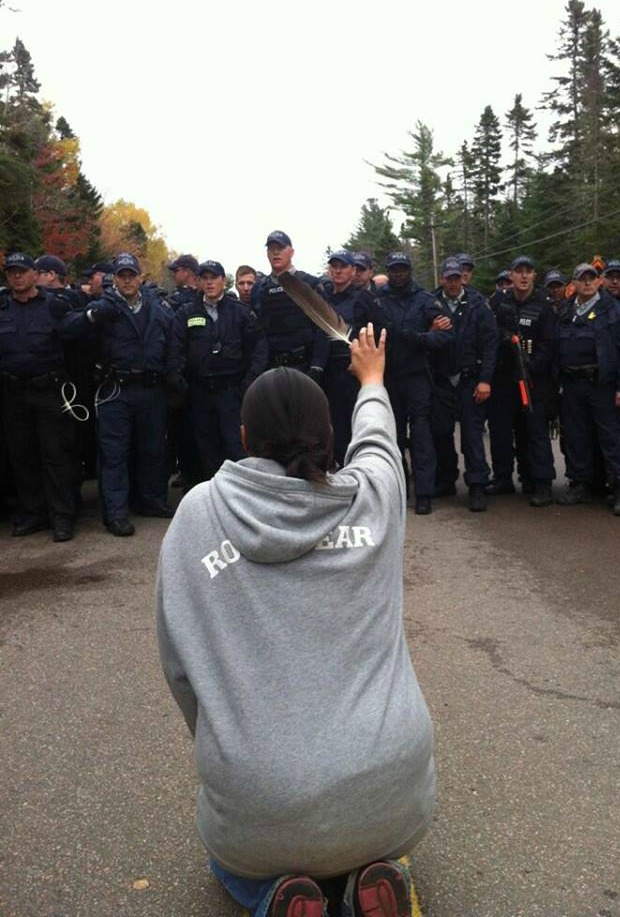
The Assembly of First Nation Chiefs of New Brunswick has called on the Alward government to talk with them about the development of natural resources, like shale gas, and acknowledge joint jurisdiction.
But did tensions rise too high last October when a shale gas protest turned violent in Rexton with police cars set on fire and Elsipogtog First Nation protesters arrested and pepper sprayed by the RCMP?
Is the relationship strained to a point where there’s no going back?
It’s been more than a decade since a similar situation turned violent in another First Nations Reserve in New Brunswick. Burnt Church First Nation’s residents fought for their fishing rights from 1999-2001. Miigam’agan, St. Thomas’s university’s elder on campus, was a leader in the community (also known as Eskinuopitijk) during those times.
She spoke about her reserve’s protest, the challenges of healing, and offered advice to Elsipogtog First Nation.
•••
After the Donald Marshall case of 1999 when the Supreme Court upheld First Nations people’s right to fish to sustain themselves, she said the Burnt Church community would wake up at four or five every morning to set traps and gather food.
“It was so wonderful, so beautiful, seeing the whole community working together. It was like a dream, and two weeks later that dream became a nightmare.”
The non-native fisherman surrounded her community and began to destroy native traps and equipment. The RCMP were called in, but stood idly by as the non-native fisherman destroyed the traps and assaulted natives who tried to save their traps, said Miigam’agan. She felt the non-native fisherman reacted that way because they felt their way of life threatened and acted out of fear of losing their livelihoods.
The following year, Miigam’agan and other community leaders felt the need to fight for their right to sustain their community through fishing. They planned on fishing again, knowing the violence would ensue.
After working with rape victims for many years, Miigam’agan knew they had to build up their case through neutral witnesses. Her community made a call out to human rights groups to observe and they videotaped many of the incidents that can still be seen online. Miiam’agan said this is the first time in history abuse against her people was ever recorded.
One night, during the fishing season, Miigam’agan saw men running and screaming from the beach claiming that they had guns pointed at them. As gunshots rang out over the water, she began to run, but then spotted her 10-year-old nephew hiding under steps. She ran to him. He asked her: “Are we going to die?” They ran to her mother’s house. Then it donned on her that it was affecting their children also.
“We had to ask ourselves, do we fight to our deaths or stay alive to expose the abuse?”
•••
Miigam’agan and other community leaders brought this question to the community. The question was resoundingly answered with: “We’re tired of fighting and our children are scared. Please think of our children first … we want them to know our culture.”
This opened up dialogue and started the healing process. She describes this process as a healing circle where all members are allowed to speak and everybody has a voice.
The non-natives were invited to sit and talk. Those who could and were willing came and had their voices heard. They said they wanted peace and for things to go back to normal.
The healing circle allowed everybody to voice their opinions. It helped the two sides realize what they wanted was similar, they just wanted to provide for their children.
She does admit that mistrust of the RCMP and government still exists, but steps are being taken to move forward.
Miigam’agan suggests that Elsipogtog First Nation develop and maintain open and honest communication with all parties involved.
She said you can’t judge a situation when you aren’t there. She compared it to a drowning person. They’ll do anything to survive and all rules are thrown out.
She said it’s also hard to talk when you feel like you’re being choked and attacked, when the air and water, a community’s lifelines, are being attacked. The conversation needs to happen because they all want the same thing, to provide for their children, Miigam’agan said. The sides may be able to sit down and come up with viable options that mutually better life for the future.
“We all just want security for our children and a better life for them.”
